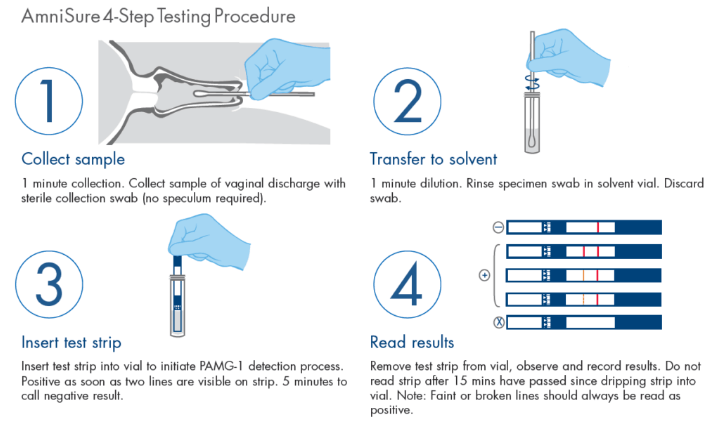PROM and PPROM > Maternal & Newborn
Exam Review
Causes and risk factors
Total Questions : 5
Showing 5 questions, Sign in for moreA nurse is caring for a client who has a history of PROM in a previous pregnancy.
The nurse knows that this client is at a higher risk of developing which complication in the current pregnancy?
Explanation
The client who has a history of PROM (premature rupture of membranes) in a previous pregnancy is at a higher risk of developing preterm labor in the current pregnancy.Preterm labor is when the baby is born before 37 weeks of gestation and can cause complications such as respiratory distress, low birth weight and infection.

A nurse is assessing a client who is at 34 weeks of gestation and reports a sudden gush of fluid from the vagina.
The nurse suspects that the client has PPROM.
Which of the following tests should the nurse perform to confirm the diagnosis?
Explanation
This is a rapid immunoassay test that detects placental alpha microglobulin-1 (PAMG-1) in vaginal fluid, which is a marker of fetal membrane rupture.It has high sensitivity and specificity and can be used in the presence of blood or other contaminants.

A nurse is teaching a pregnant client who smokes about the effects of smoking on the pregnancy.
The nurse should include that smoking increases the risk of which of the following conditions?
Explanation
Smoking increases the risk of various complications for both the mother and the fetus, such as:
• Intrauterine growth restriction: Smoking reduces blood flow and nutrient transfer to the fetus, resulting in small size for gestational age.
• Premature rupture of membranes: Smoking causes maternal vasoconstriction, decreases placental perfusion, and induces uterine contractions, which can lead to early rupture of the amniotic sac.
• Placental abruption: Smoking also increases the risk of placental detachment from the uterine wall, which can cause severe bleeding and fetal distress.
A nurse is reviewing the ultrasound report of a pregnant client who is at 28 weeks of gestation.
The report indicates that the client has polyhydramnios, which is an excess of amniotic fluid.
The nurse should recognize that this condition can cause which of the following complications? (Select all that apply.).
Explanation
Polyhydramnios is a condition where there is too much amniotic fluid in the uterus during pregnancy.This can cause various complications for both the mother and the fetus.
A nurse is caring for a client who has an incompetent cervix and is at 20 weeks of gestation.
The nurse should expect the provider to order which of the following interventions to prevent preterm birth and PPROM?
Explanation
Cerclage placement is a way of keeping the cervix closed during pregnancy to prevent premature birth and PPROM (preterm premature rupture of membranes) due to incompetent (weakened) cervix.A cerclage is the placement of a band or suture for reinforcement to help prevent the amniotic sac from “funneling” down into the cervix prematurely.
Sign Up or Login to view all the 5 Questions on this Exam
Join over 100,000+ nursing students using Nursingprepexams’s science-backend flashcards, practice tests and expert solutions to improve their grades and reach their goals.
Sign Up Now

